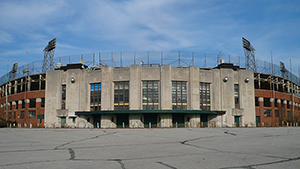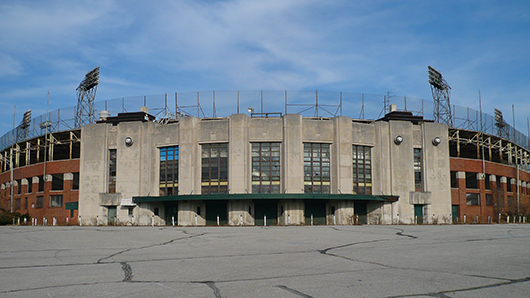
Strecker’s living room is located behind home plate of historic Bush Stadium. Strecker, a self-proclaimed baseball fanatic, was the first resident to sign a lease last January for Stadium Lofts. The studio, one- and two-bedroom rental units at 1510 Stadium Way were filled by the time it opened July 27.
Now the former Indianapolis Indians stadium is growing with new life. In addition to the 138 lofts, Core Redevelopment will open 144 flats in August, The Indianapolis Star reported.
The Near-Westside complex has a rich history that dates to the stadium’s opening in 1931. The ballpark hosted Pan Am Games baseball in 1987 and was a stand-in for Chicago’s Comiskey Park in the movie Eight Men Out. But in 1996, the minor league Indianapolis Indians baseball team moved from Bush to its current home downtown at Victory Field. And a year later, Bush Stadium became the 16th Street Speedway.
That venture failed, and eventually the old field became a landing site for vehicles from the federal “cash for clunkers” program.
“There was no Plan B for the stadium. It was either this project or demolition,” said Marsh Davis, president of Historic Landmarks.
Described by Davis as “prime real estate,” the new apartment complex is a win-win for both developers and preservationists. “This preserves the essence of the place and is an attractive development,” Davis said.
Core Redevelopment came on board in 2010 and worked with city leaders and neighborhood representatives to create and fine-tune a plan that ended up costing $13 million. The city funded $5 million of that, said Maggie LaRoche, senior property manager.
“The city got behind us. We didn’t have to adhere to the original structure, but our motto is ‘don’t fight the building,’” LaRoche said.
So even absent a pitcher on the mound, popcorn and fly balls, visitors and residents still feel baseball in the air.
The ivy is no longer on the outfield wall, but many features stand still in time. Ticket windows are closets and pantries. The ornate Art Deco columns and iron turnstiles mark the main entrance. And 1960s stadium seating adorns the lobby. The infield diamond is stamped in concrete, and the lights that illuminated night games soar over the former grandstand. The interior walls are lined with black-and-white photos from the early years, a multipurpose room has been named “The Bull Pen,” and each unit is marked by a stadium seat number.
It’s the perfect fit for Strecker, who teaches in the English department at Ball State University and says her passion for baseball predates the AAA Indians’ move to Victory Field.
Her one-bedroom apartment rents for $699 a month. Two-bedrooms units lease for $1,199. Each apartment includes cherry kitchen cabinetry, granite countertops, stainless steel appliances and full-size washers and dryers. Ground-floor apartments step onto the green space of the baseball field, and upper-level apartments are equipped with balconies.
Strecker has used her living space as a sort of mini baseball museum. Her collection of memorabilia includes a stadium ticket from the 1930s, a 1931 chair from the stadium and a steamer trunk that once belonged to major leaguer Dave Philley. She also has a cap that was signed by Mamie “Peanut” Johnson, one of three women and the first female pitcher to play in the Negro Leagues. She signed with the Indianapolis Clowns in 1953.
Just a few steps outside Strecker’s sliding glass door is a scoreboard. The repurposed grounds include a sand volleyball pit, disc golf course and golf swing cage for tenants. Other amenities include three private conference areas and storage units.
Residents have access to pedestrian trails – including a path connecting to the IUPUI campus. Stadium Lofts is one phase of a long-range plan introduced in 2010 by Develop Indy. The plan includes a certified technology park – 16 Tech – offering 1 million square feet of development and redevelopment opportunities.
“It’s good for the neighborhood because it shows improvements and the potential for new developments,” said Jeremy Littell, president of the Riverside Civic League and a neighborhood resident. With additional commercial space available at 16th and Harding streets, Littell said he’s optimistic about continued growth.
“Lots of people have memories of concerts and ball games at this site, and it’s just nice to see it continue as a vital part of the neighborhood.”
___
Information from: The Indianapolis Star, http://www.indystar.com
Copyright 2013. Associated Press. All rights reserved. This material may not be published, broadcast, rewritten, or redistributed.
AP-WF-12-02-13 1521GMT
ADDITIONAL IMAGE OF NOTE



